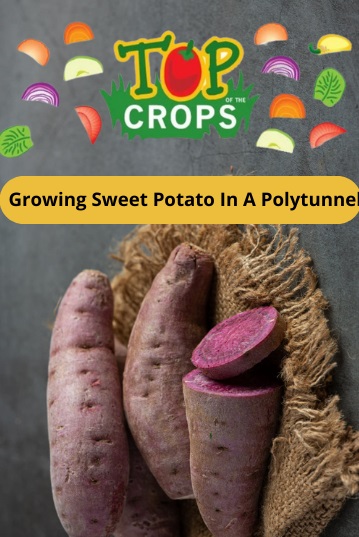Sweet potato crops have traditionally been cultivated in warmer climates. But more and more people are choosing to utilise polytunnels in order to grow this delicious root vegetable in our cooler temperate climate. Hardier varieties are now available that make this a much more viable proposition for UK growers.
| Jan | Feb | Mar | Apr | May | Jun | Jul | Aug | Sep | Oct | Nov | Dec | |
| Plant |  |
 |
||||||||||
| Harvest |  |
 |
Sweet potatoes (Ipomoea batatas) are a delicious, nutritious crop, and with the use of a polytunnel, it is well suited to any garden. Packing a powerful punch of flavour, nutrients and vitamins, they can be used in a variety of sweet and savoury dishes.
Boasting a similar texture and versatility to common white potatoes, sweet potatoes have a delicately sweet flavour that makes them ideal for use in curries, stews and sweet treats, as well as being turned into healthy chips and crisps. Their leaves are also delicious when treated like spinach or added to soups and salads.
While sweet and white might both share the name “potato,” they are not actually closely related! The sweet potato is related to the morning glory family, while white potatoes belongs to the nightshade genus.
Rather than being grown from seed, like many other common crops, sweet potatoes are typically grown from cuttings, known as sweet potato slips when they are not yet rooted, and as plug plants when they are rooted and sold in containers or small pots.
When you start looking around for your slips or plug plants, it is important that you choose them from a company that sells hardy varieties that are suited to the UK. If you plant tropical variants, they will not survive in our cooler weather and shorter growing seasons.
Sweet potatoes typically have a long growing season, so you will want to plant your slips as early in the season as possible. Cover the soil to warm it in late March or April, and get the slips in the ground as soon as you notice the temperatures rising (usually late May or early June).
Rather than purchasing slips you can if you wish take cuttings from a sweet potato that you have purchased, or one that you grew yourself last year.
You can grow new sweet potatoes from a supermarket sweet potato. But note that the sweet potato you use might not be of a variety that is suited to UK cultivation and so may not thrive in your garden as one of the recommended varieties for UK growers would do. You will also have to choose organic as non-organic sweet potatoes will often be coated with an anti-sprouting agent.
If you do wish to grow your own cuttings then you should do so in spring.
Place the sweet potato in a tray or pot of moist sand in a warm location such as an airing cupboard or heated propagator in order to encourage it to sprout.
Once the potato has sprouted, allow the leafy shoots to grow to around 5-7.5cm long, then cut them off at the base with a clean, sharp knife.
Place the cuttings into small pots of moist, peat-free, multi-purpose potting mix and place them in a heated propagator or on a warm windowsill. They should root easily and won't take long to do so.
As soon as your young plants have rooted well and are growing strongly, these can be moved into their final growing positions after all risk of frost has passed and once you have hardened them off to gradually get them used to the growing conditions.
While you might be eager and tempted to plant your slips as soon as you can, don’t put them in the soil too early. Instead, keep them on a sunny windowsill in your home until they are 15-30cm tall. Pot them up into slightly larger containers as required until it is time to plant them out.
Of course, before you plant out your slips or plug plants, you need to decide on a suitable growing location. It is crucial to make sure that you provide the conditions that these plants require or you may have disappointing yields, or even fail to obtain a harvest at all.
To find the right location to grow sweet potatoes, you need to think about temperatures, light levels, and the soil or growing medium provided.
You will have the best success with your sweet potatoes if they are at a temperature of 21-26 degrees Celsius. While the South of the UK usually reaches these temperatures in the summer (and then some), some areas in the North might need to take additional warming measures.
A polytunnel will naturally make it easier to grow these crops successfully because sweet potatoes will enjoy the warm and sheltered conditions that the structure can provide.
Sweet potatoes do best in sandy soil that is reasonably warm and drains freely. If your garden’s soil doesn’t match this description you might have a lot more success if you plant the slips in raised beds or large containers, placed in the sunniest part of your polytunnel.
If you are growing in a container, make sure that this is at least 30cm across, and filled with a suitable, good-quality, peat-free potting mix.
Even in a polytunnel, in some regions additional protection from row covers or cloches may also still be required to provide the requisite temperatures and conditions.
The main thing to get right when growing sweet potatoes are the growing conditions. Get those right, along with some simple care, and you cannot go too far wrong.
Remember that in most locations here in the UK, sweet potatoes are best grown undercover in a greenhouse or polytunnel, and they will only really thrive outside in the very warmest, sunniest and most sheltered of southern gardens.
Sweet potatoes appreciate a lot of water, and it is a good idea to feed them with a high potassium feed, such as comfrey tea, for example, every two weeks or so. Remember that plants in pots will typically require watering and possibly feeding too more often than those growing in the ground.
If space is limited, vertical growing can be a good idea. Provide your sweet potato vines with vertical supports such as a wigwam of natural branches or bamboo canes around 1.8m in height. You might also use a range of different trellises or other support structures for your climbing plants, tying in your sweet potato plants to the support structure as they grow.
Understanding when your sweet potatoes are ready to harvest is easier than you may imagine.
As soon as you see that your sweet potatoes are big enough to cook with, you can start harvesting them (this is usually 3 to 4 months – i.e. 100 days - after you plant the slips). Another way you can tell that they are ready to harvest is when the leaves start to yellow, but don’t worry – you can leave them in the ground until the first frost.
You might want to use a spade fork for the harvesting process, because the roots spread about 6 inches. You can feel free to cut some of the vines away, and then pull up the crown carefully so that you do not bruise the sweet potato. Shake away the dirt, but don’t wash them, as water can hasten rot.
It is always a good idea to cure your sweet potatoes to increase their sweetness. This allows them to develop a second skin over any scratches that occurred when you unearthed then. In order to cure them, store them in a warm environment at high humidity (80°F/27°C and about 90%) for between 10 to 14 days. You can then store them in newspaper in a cool, dry place for approximately 6 months.
Remember that you may be able to save back sweet potatoes that are of good quality from your harvest to propagate new sweet potato slips for next year.
You can also propagate sweet potatoes by taking cuttings from the growing plants during the summer. These cuttings can be rooted in water or in potting mix/soil, and can be overwintered in a frost-free location and planted out the following spring.
Varieties of sweet potato recommended for UK growers are:
Beauregard Improved
Bonita
Evangeline
Kaukura
Tahiti
As long as sweet potatoes are grown in a suitable location, that is sunny, warm and sheltered, with a moist yet free draining soil or growing medium, they are typically largely hassle-free and remain healthy and vigorous.
However, they can experience a range of problems when the conditions are not quite right, and may also be affected by common undercover growing pests such as red spider mites and whitefly, for example.
When growing sweet potatoes in a polytunnel, remember that if a severe frost threatens, additional protection may still be required for your crop in some regions of the UK.
However, in most cases, having a polytunnel will make growing sweet potatoes much, much easier for most home growers, since the plants will be afforded some protection from the weather outside.
Just make sure that you water consistently and well throughout the whole of the growing season. A good irrigation system in your polytunnel will make this job much easier. Ideally, water should be delivered at the base of the plant and not wet the foliage if possible.
Mulch well around your plants for water conservation etc... and companion plant for effective environmental improvement and to aid with pest control. Some companion plants for sweet potatoes to consider are legumes, radishes, spinach or lettuce, marigolds, garlic and a number of aromatic herbs.
Hollohan, J., (2023) 3 Clear Signals Your Sweet Potatoes Are Ready to Be Harvested (Plus Tips on Storing Them). A-Z Animals. [online] Available at: https://a-z-animals.com/blog/clear-signals-your-sweet-potatoes-are-ready-to-be-harvested-plus-tips-on-storing-them/ [accessed 25/01/24]
